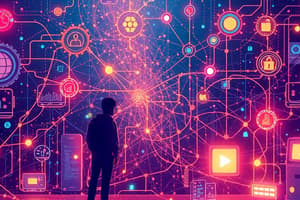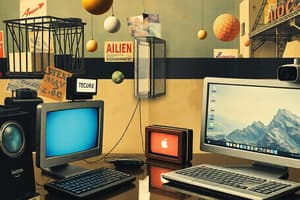Podcast
Questions and Answers
What is the primary purpose of the Arduino IDE?
What is the primary purpose of the Arduino IDE?
- To allow users to program Arduino boards and experiment with sensors (correct)
- To provide advanced graphics for project visualization
- To serve as a database for Arduino projects
- To compile complex algorithms for high-speed computing
Which microcontroller is used in the Arduino Uno?
Which microcontroller is used in the Arduino Uno?
- ATmega16
- ATmega328P (correct)
- PIC16F84
- STM32F103
How many digital I/O pins does the Arduino Uno have?
How many digital I/O pins does the Arduino Uno have?
- 16
- 14 (correct)
- 8
- 10
Which pins on the Arduino Uno are used for I²C communication?
Which pins on the Arduino Uno are used for I²C communication?
What function is executed first when the Arduino completes its startup routine?
What function is executed first when the Arduino completes its startup routine?
What is the maximum input voltage that can be supplied to the Arduino Uno?
What is the maximum input voltage that can be supplied to the Arduino Uno?
Which programming languages are primarily supported by the Arduino IDE?
Which programming languages are primarily supported by the Arduino IDE?
What does the Serial Monitor in the Arduino IDE do?
What does the Serial Monitor in the Arduino IDE do?
What is a primary reason traditional internet protocols are inadequate for IoT?
What is a primary reason traditional internet protocols are inadequate for IoT?
Which statement correctly describes the purpose of a communication protocol in IoT?
Which statement correctly describes the purpose of a communication protocol in IoT?
Which of the following is a core requirement for an IoT protocol stack?
Which of the following is a core requirement for an IoT protocol stack?
What role does the Adaptation Layer serve in the IoT protocol stack?
What role does the Adaptation Layer serve in the IoT protocol stack?
Which protocol is designed to support energy-efficient routing in constrained networks?
Which protocol is designed to support energy-efficient routing in constrained networks?
What is a major challenge associated with SixLoWPAN?
What is a major challenge associated with SixLoWPAN?
What is a significant advantage of CoAP in an IoT context?
What is a significant advantage of CoAP in an IoT context?
Which layer uses UDP for efficient communication in the IoT protocol stack?
Which layer uses UDP for efficient communication in the IoT protocol stack?
What function begins after the setup() function completes its execution?
What function begins after the setup() function completes its execution?
Which method is used to add custom library files in the Arduino IDE?
Which method is used to add custom library files in the Arduino IDE?
Which of the following components is essential to interface an LCD with Arduino using I2C?
Which of the following components is essential to interface an LCD with Arduino using I2C?
Which Arduino board option is NOT a valid example listed for selection?
Which Arduino board option is NOT a valid example listed for selection?
What is the purpose of the potentiometer when using an LCD with an I2C module?
What is the purpose of the potentiometer when using an LCD with an I2C module?
Which of the following pins is NOT connected to the I2C module?
Which of the following pins is NOT connected to the I2C module?
What is the function of the I2C address in an I2C setup with an LCD?
What is the function of the I2C address in an I2C setup with an LCD?
At which location do you select the communication port in the Arduino IDE?
At which location do you select the communication port in the Arduino IDE?
What is the primary function of the soil moisture sensor in the interfacing project?
What is the primary function of the soil moisture sensor in the interfacing project?
Which component is NOT required when setting up the soil moisture sensor with Arduino?
Which component is NOT required when setting up the soil moisture sensor with Arduino?
When the flame detector sensor detects a flame, what signal does it output?
When the flame detector sensor detects a flame, what signal does it output?
What is the purpose of the potentiometer in the sound sensor setup?
What is the purpose of the potentiometer in the sound sensor setup?
Which digital pin is assigned to read the IR sensor in its interfacing project?
Which digital pin is assigned to read the IR sensor in its interfacing project?
What action is performed by the servo motor when an obstacle is detected by the IR sensor?
What action is performed by the servo motor when an obstacle is detected by the IR sensor?
What is the threshold level for triggering the buzzer in the soil moisture project?
What is the threshold level for triggering the buzzer in the soil moisture project?
Which method is used to read the moisture value from the soil moisture sensor?
Which method is used to read the moisture value from the soil moisture sensor?
What is the primary function of the ESP8266 module in the described project?
What is the primary function of the ESP8266 module in the described project?
Which sensor is used to measure Volatile Organic Compounds (VOCs) in the Indoor Air Pollution Management system?
Which sensor is used to measure Volatile Organic Compounds (VOCs) in the Indoor Air Pollution Management system?
What type of connection is necessary between the ESP8266 module and the Arduino Uno for RX/TX communication?
What type of connection is necessary between the ESP8266 module and the Arduino Uno for RX/TX communication?
Which library is NOT mentioned as a requirement for implementing the project?
Which library is NOT mentioned as a requirement for implementing the project?
What is the main purpose of the DHT11 sensor in this project?
What is the main purpose of the DHT11 sensor in this project?
Which component acts as the central microcontroller for processing data in the project?
Which component acts as the central microcontroller for processing data in the project?
What type of sensor is the SDS011 in the context of air quality monitoring?
What type of sensor is the SDS011 in the context of air quality monitoring?
Which component serves as a visual indicator for system status in the Indoor Air Pollution Management system?
Which component serves as a visual indicator for system status in the Indoor Air Pollution Management system?
What is the primary function of the Wire Library in this context?
What is the primary function of the Wire Library in this context?
How does the ESP8266 contribute to the Indoor Air Pollution Management system?
How does the ESP8266 contribute to the Indoor Air Pollution Management system?
Which of the following is a key takeaway regarding the architecture of the system?
Which of the following is a key takeaway regarding the architecture of the system?
Why is maintaining good indoor air quality (IAQ) particularly important?
Why is maintaining good indoor air quality (IAQ) particularly important?
What type of contaminants commonly contribute to poor indoor air quality?
What type of contaminants commonly contribute to poor indoor air quality?
Which historical figure is mentioned as advocating for good air exchange in hospitals?
Which historical figure is mentioned as advocating for good air exchange in hospitals?
What does the World Health Organization recommend to improve indoor air quality?
What does the World Health Organization recommend to improve indoor air quality?
What common indoor pollutant can accumulate particularly in basements?
What common indoor pollutant can accumulate particularly in basements?
Flashcards
IoT Communication Protocols
IoT Communication Protocols
Rules for devices to exchange data in an IoT network, supporting low-power, resource-constrained devices.
Traditional Internet Protocols (Issues)
Traditional Internet Protocols (Issues)
Large headers, high energy consumption, and inefficient in low-bandwidth environments, making them unsuitable for IoT devices.
Low Power Consumption (IoT)
Low Power Consumption (IoT)
A must-have feature in IoT protocols to extend device battery life.
High Reliability (IoT)
High Reliability (IoT)
Signup and view all the flashcards
SixLoWPAN
SixLoWPAN
Signup and view all the flashcards
RPL (Routing Protocol)
RPL (Routing Protocol)
Signup and view all the flashcards
CoAP (Constrained Application Protocol)
CoAP (Constrained Application Protocol)
Signup and view all the flashcards
IoT Protocol Stack
IoT Protocol Stack
Signup and view all the flashcards
Arduino Uno
Arduino Uno
Signup and view all the flashcards
ATmega328P
ATmega328P
Signup and view all the flashcards
Digital I/O Pins
Digital I/O Pins
Signup and view all the flashcards
Serial Monitor
Serial Monitor
Signup and view all the flashcards
setup() function
setup() function
Signup and view all the flashcards
Sketch
Sketch
Signup and view all the flashcards
Arduino IDE
Arduino IDE
Signup and view all the flashcards
I/O Pins
I/O Pins
Signup and view all the flashcards
Arduino setup() function
Arduino setup() function
Signup and view all the flashcards
Arduino loop() function
Arduino loop() function
Signup and view all the flashcards
Arduino Library Manager
Arduino Library Manager
Signup and view all the flashcards
I2C Module
I2C Module
Signup and view all the flashcards
Arduino Board Selection
Arduino Board Selection
Signup and view all the flashcards
I2C Communication
I2C Communication
Signup and view all the flashcards
Arduino Serial Communication
Arduino Serial Communication
Signup and view all the flashcards
Arduino Port Selection
Arduino Port Selection
Signup and view all the flashcards
Soil Moisture Sensor
Soil Moisture Sensor
Signup and view all the flashcards
Flame Detector Sensor
Flame Detector Sensor
Signup and view all the flashcards
Sound Sensor
Sound Sensor
Signup and view all the flashcards
IR Sensor
IR Sensor
Signup and view all the flashcards
AnalogRead()
AnalogRead()
Signup and view all the flashcards
digitalRead()
digitalRead()
Signup and view all the flashcards
Servo Motor
Servo Motor
Signup and view all the flashcards
Arduino Threshold
Arduino Threshold
Signup and view all the flashcards
Indoor Air Quality (IAQ)
Indoor Air Quality (IAQ)
Signup and view all the flashcards
Indoor Air Pollution Management System
Indoor Air Pollution Management System
Signup and view all the flashcards
Sensors Used
Sensors Used
Signup and view all the flashcards
IAQ Impact on Health
IAQ Impact on Health
Signup and view all the flashcards
Microcontroller
Microcontroller
Signup and view all the flashcards
Common Indoor Pollutants
Common Indoor Pollutants
Signup and view all the flashcards
Data Transmission
Data Transmission
Signup and view all the flashcards
WHO Recommendations for IAQ
WHO Recommendations for IAQ
Signup and view all the flashcards
Wire Library
Wire Library
Signup and view all the flashcards
ThingSpeak Platform
ThingSpeak Platform
Signup and view all the flashcards
Servo Library
Servo Library
Signup and view all the flashcards
Visual Feedback (LED)
Visual Feedback (LED)
Signup and view all the flashcards
ESP8266 Module
ESP8266 Module
Signup and view all the flashcards
Software Libraries
Software Libraries
Signup and view all the flashcards
Key Applications
Key Applications
Signup and view all the flashcards
Study Notes
Introduction to IoT
- IoT is a network connecting physical objects embedded with sensors, software, and connectivity.
- It collects and exchanges data to transform devices (appliances, vehicles, wearables) into smart devices.
- IoT phases evolved from basic connectivity to immersive experiences and the Internet of Things itself.
Evolutionary Phases
- Connectivity Phase: Early internet enabled human interactions (email, web services).
- Network Economy Phase: Digitalized businesses and e-commerce advanced.
- Immersive Experiences Phase: Enhanced user engagement through media and social platforms.
- Internet of Things Phase: Focuses on connecting physical objects to create smarter interactions.
How IoT Works
- Collection: Devices gather data via sensors.
- Communication: Data is transmitted to cloud platforms through protocols like Zigbee, Bluetooth, or Wi-Fi.
- Analysis: Data is processed for insightful information.
- Action: Corresponding actions are taken based on analysis (e.g., temperature adjustments, turning lights on/off).
Applications of IoT
- Smart Homes: Light, HVAC, and security automation.
- Manufacturing: Efficiency enhancements with smart sensors.
- Transportation: Self-driving cars and traffic management.
- Agriculture: Livestock health monitoring.
- Healthcare: Wearable devices for health tracking.
- Security: Smart locks and surveillance.
- Industrial IoT (IIoT): Automation in industrial procedures.
IoT Working Groups and Standards
- Organizations like IETF, OCF, IoT Security Foundation, and IIC develop IoT standards and promote interoperability.
Architecture of IoT
- Sensing Layer: Devices, sensors, and RFID collect data.
- Network Layer: Communication (Zigbee, Bluetooth, Wi-Fi), managing latency and security.
- Application Support Layer: Data analytics, security, and machine learning functions.
- Application Layer: User-facing apps processing and connecting real-time data with physical and digital worlds.
IoT Communication Protocols
- IoT protocols facilitate seamless data exchange between devices.
- Traditional Internet protocols are insufficient for IoT devices due to limited processing power and memory.
- Core requirements involve low power usage, high reliability, internet connectivity, and open standards.
Standardized IoT Protocols
- SixLoWPAN: IPv6 over low-power wireless personal area networks, compressing IPv6 headers.
- RPL: Routing Protocol for Low-Power and Lossy Networks, enabling energy-efficient routing.
- CoAP: Constrained Application Protocol for web-like communication and low-power devices operating over UDP.
Understanding Microcontrollers
- Microcontrollers, the core of Arduino, handle processing instructions and data.
- Key features include CPU for processing, memory for storage (RAM and Flash), and peripherals for communication (GPIO, ADCs, communication modules).
Arduino Boards/Types
- Different Arduino boards, adapted for distinct tasks.
- Example Boards: Uno, Nano, Leonardo, Micro, and Zero (varying functionalities and microcontroller type)
Features of Arduino IDE
- The Arduino IDE provides a user-friendly interface for programming Arduino boards.
- It has a menu bar, toolbar, a text editor, and a status bar to streamline programming, compilation and uploading processes.
- Crucial functions: Verify, Upload, New/Open/Save, Serial Monitor.
Interfacing LCD with I2C
- LCD displays can connect to Arduino using I2C modules for reduced pin requirements.
- Understanding LCD display, I²C module, potentiometer for contrast control and associated components.
Interfacing Sensors with Arduino
- Specific examples on connecting various sensors (soil moisture, DHT11 temperature/humidity, MQ7 gas, water level, flame, sound.) with Arduino.
- Understanding sensor specifications, wiring, and Arduino code for acquiring and processing sensor-obtained values.
Interfacing ESP8266 with Arduino
- Integrating an ESP8266 Wi-Fi module with Arduino devices for wireless data transmission (e.g., sending sensor data to the internet).
Indoor Air Pollution Management
- Arduino is used to monitor and manage Indoor air pollution with multiple sensors.
- Multiple sensors like the DHT11 (temperature/humidity), CCS811 (VOCs/CO2), SDS011 (PM10/PM2.5), and multi-gas sensors are integrated for holistic air quality monitoring.
Arduino-Based Greenhouse Monitoring System
- An Arduino-based system monitors greenhouse conditions including temperature, humidity, light levels, soil moisture, and water levels.
- The system can automate irrigation, ventilation, and other processes based on real-time data.
Studying That Suits You
Use AI to generate personalized quizzes and flashcards to suit your learning preferences.




